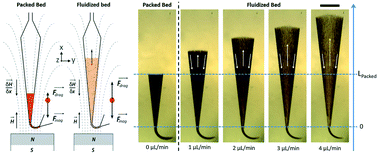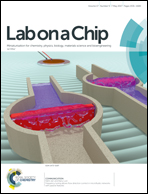Magnetic fluidized bed for solid phase extraction in microfluidic systems†
Abstract
Fluidization, a process in which a granular solid phase behaves like a fluid under the influence of an imposed upward fluid flow, is routinely used in many chemical and biological engineering applications. It brings, to applications involving fluid–solid exchanges, advantages such as high surface to volume ratio, constant mixing, low flow resistance, continuous operation and high heat transfer. We present here the physics of a new miniaturized, microfluidic fluidized bed, in which gravity is replaced by a magnetic field created by an external permanent magnet, and the solid phase is composed of magnetic microbeads with diameters ranging from 1 to 5 μm. These beads can be functionalized with different ligands, catalysts or enzymes, in order to use the fluidized bed as a continuous purification column or bioreactor. It allows flow-through operations at flow rates ranging from 100 nL min−1 up to 5 μL min−1 at low driving pressures (<100 mbar) with intimate liquid/solid contact and a continuous recirculation of beads for enhanced target capture efficiencies. The physics of the system presents significant differences as compared to conventional fluidized beds, which are studied here. The effects of magnetic field profile, flow chamber shape and magnetic bead dipolar interactions on flow regimes are investigated, and the different regimes of operation are described. Qualitative rules to obtain optimal operation are deduced. Finally, an exemplary use as a platform for immunocapture is provided, presenting a limit of detection of 0.2 ng mL−1 for 200 μL volume samples.



 Please wait while we load your content...
Please wait while we load your content...